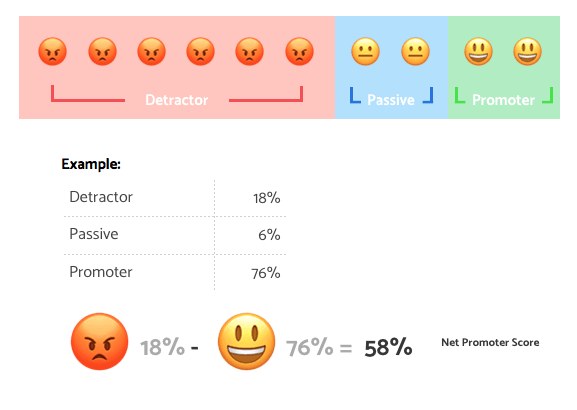Do Your Customers Love You As Much As You Think? – A Short Guide To NPS
Table of Contents
No matter how much you think your customers love you, how can you be certain?
Step up, Net Promoter Score (or NPS for those who love acronyms). NPS is a system that allows you to easily understand the loyalty of your customers and helps you identify your brand’s top promoter, which most companies class as their ‘ideal customer’.
Understanding, tracking and making steps to improve your NPS will uncover key opportunities for product, process or service development.
The aim of the game: keep your customers sweet!
First, it’s important to learn what the different categories are, and what they mean.
Promoter – Someone who truly understands your vision and will influence other potential customers to use you!
Passive – Someone who is likely not to recommend you any time soon and may influence your current or prospective clients away from you.
Detractor – Someone who will go out of their way to influence your current or prospective clients away from you.
Sounds great, but how do I calculate my NPS?
- First, question your customers ‘On a scale of 0 – 10, how likely are you to recommend us to a friend?’. There are many automated tools to gather this information, but to get you started, just send out a simple email and keep track of the responses.
- Categorise the responses! 0 – 6 are Detractors, 7 – 8 are Passives and 9 – 10 are Promoters.
- Now for some Maths! We’re not worried about Passives, we only want to focus on Promoter and Detractor responses. Subtract the percentage of Detractor responses from the percentage of Promoter responses to get your NPS.

I’ve got my NPS Score… What next?
Track your results! Set up a spreadsheet and log all of the results on a monthly basis.
Every month, ask a new set of customers the same questions from month 1 and record the results in your spreadsheet. It’s important that you keep everything the same from month 1 to month 2 – this way you’re able to accurately track your progress. Of course, there are tonnes of automated, fancy pants pieces of software that can do this for you whilst making you a soya flat white, but in truth, it’s simple enough to start gathering the data in a spreadsheet first before committing to any software.
Naturally, when you’re aware that you’re tracking your NPS, you will find a slight increase in the score from the previous month. However, take the data from the previous month and start listening to what your customers are saying. If they are likely not to recommend you, try and figure out why that may be. Go back through your processes and try and find potential flaws to understand the given score in more detail.
When you start gathering up data, you will soon want to learn more about your customer’s journey, and it will be worth adding an open-ended question into your survey to listen to more specific requirements or reasons to the given score.
Simply put, do something about it and start making positive changes!
Does it really work?
On the contrary to popular belief, understanding your NPS is not reserved for mega-corporate companies. In fact, all businesses from one man bands to SME’s looking to accelerate their business growth should have a strong hold on the meaning and learning of this data.
Your customers are your most valuable critic. It’s time to stop listening too what YOU think is working and hear it from those spending their money on your offering.
Here’s what you’ll expect to see when tracking and making positive changes to increase your NPS:
- Higher customer engagement
- Increase in customer retention and repeat business
- Increase in referral leads
- An overall better product or service offering
Hopefully, after reading this you can see value in using the NPS system to track your customer loyalty. Whilst the system is still fairly underused by many companies, understanding your NPS could just be that gear shift in taking your business to the next level.
